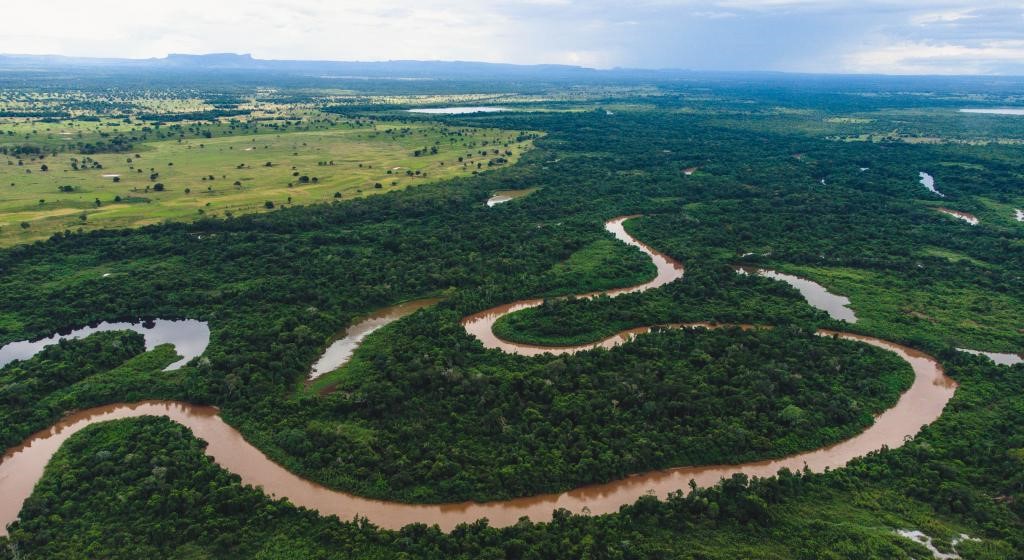
Disclaimer: Copyright infringement not intended.
Context
- Eight South American countries have united in an effort to combat deforestation in the Amazon rainforest.
- The Amazon Cooperation Treaty Organisation (ACTO) summit, held in Brazil, aimed to prevent the rainforest from reaching a "point of no return" and outlined a joint strategy to address deforestation.
Details
Historic Relevance
- The ACTO summit held in Brazil marked a significant event as it was the first time in 14 years that the organization convened.
- ACTO, established in 1995 by South American countries sharing the Amazon basin, holds the potential to address ongoing challenges related to the Amazon rainforest and its preservation.
Member Countries and Declaration
- The member countries involved in this initiative are Bolivia, Brazil, Colombia, Ecuador, Guyana, Peru, Suriname, and Venezuela.
- They signed a joint declaration at the summit held in Belém, Brazil, which laid out a comprehensive plan to promote sustainable development, halt deforestation, and combat organized crime related to deforestation.
Shared Agenda and Roadmap
- During the summit, the participating countries adopted what Brazil referred to as a "new and ambitious shared agenda.
- This agenda involves a nearly 10,000-word roadmap that outlines strategies for sustainable development and environmental conservation in the Amazon region.
Deforestation Prevention
- The roadmap emphasizes the need to prevent deforestation by implementing stricter regulations, monitoring illegal activities, and enforcing penalties for those involved in illegal logging and land clearance.

Promotion of Sustainable Development
- The member countries intend to promote economic growth while ensuring the sustainable use of natural resources. This includes supporting responsible agricultural practices, eco-tourism, and indigenous-led conservation efforts.
Combatting Organized Crime
- The summit addressed the issue of organized crime linked to deforestation. By targeting criminal networks engaged in illegal logging and land conversion, the countries aim to disrupt the drivers of deforestation.
Shortcomings and Unmet Demands
- While the summit marked progress, it did not fully satisfy the demands of environmentalists and Indigenous groups. Notable unmet demands included Brazil's pledge to end illegal deforestation by 2030 and Colombia's commitment to cease new oil exploration.
Leaders' Commitments
- Brazilian President Luiz Inacio Lula da Silva and Colombian President Gustavo Petro highlighted the urgent need for collective action in response to the worsening climate crisis.
- They emphasized the importance of unity among nations to address the challenges posed by deforestation and climate change.
- President Petro proposed a unique solution during the summit—a plan to cancel developing countries' debt in exchange for robust climate protection efforts. This concept drew inspiration from the post-World War II "Marshall Plan," linking economic relief to climate conservation.
Civil Society's Role
- Environmentalists, activists, and Indigenous groups actively participated in the summit, organizing marches and demonstrations.
- Their presence aimed to exert pressure on the attending heads of state, urging them to take more aggressive action to address the Amazon's critical state.
Belem Declaration
- The summit aimed to address sustainable development in the Amazon Basin but fell short of achieving consensus on crucial environmental targets.
Absence of Protection Goals
- The proposed goal, put forth by Colombia, was to protect 80% of the Amazon from deforestation and degradation by 2025.
- However, this proposal lacked unanimous support from all member countries, leading to the absence of a clear joint goal in the Belem Declaration, the summit's outcome document.
- Without a shared commitment, the protection of the rainforest from reaching an irreversible tipping point remains uncertain.
Significance of Protection Goals
- Scientists have warned that crossing a 20-25% threshold of combined deforestation and degradation in the Amazon could trigger an irreversible tipping point, resulting in ecosystem collapse.
- Deforestation and degradation beyond this point could lead to catastrophic consequences for biodiversity, climate regulation, and local communities.
Focus on Sustainability and Mining
- Instead of agreeing on protection goals, leaders emphasized "initiating a dialogue" on sustainability in mining and fossil fuel-related activities.
- The absence of a commitment to stop oil drilling suggests a continuation of fossil fuel exploitation in the region.
Convention on Biological Diversity's Global Biodiversity Framework
- The lack of consensus on protected areas could impact the goals set under the Convention on Biological Diversity's Global Biodiversity Framework, agreed upon in December 2022.
- The framework aimed to protect at least 30% of land and sea by 2030.
- The Amazon's significant biodiversity and role in global ecosystems make it crucial for the achievement of these targets.
Indigenous Knowledge and Participation
- The Belem Declaration recognizes the importance of Indigenous knowledge for biodiversity conservation and calls for the full and effective participation of Indigenous Peoples in decision-making.
- Indigenous communities play a vital role in preserving both cultural heritage and the environment.
Forest Economy Solutions and Sustainable Use of Biodiversity
- The summit acknowledged the need for diverse forest economy solutions to counter the dominance of agricultural commodities as an economic model in the region.
- The declaration emphasizes the sustainable use of biodiversity resources in the Amazon.
Financial Considerations
- The Belem Declaration does not outline specific financial commitments to fund its proposed objectives.
- The expansion of Brazil's "Amazon fund" to cover the region and the establishment of a working group for discussing financial needs and resource mobilization are potential avenues.
.jpg)
Amazon Rainforest
Geographical Extent
- The Amazon Rainforest sprawls over approximately 5.5 million square kilometers, covering parts of Brazil, Peru, Colombia, and several other countries.
- Its vast expanse and diverse landscapes range from dense jungles to savannas and floodplains.
Biodiversity and Flora
- Renowned as a biodiversity hotspot, the Amazon houses an estimated 390 billion individual trees, representing around 16,000 species.
- A remarkable variety of plant species, from towering canopy trees to epiphytes and understory vegetation, contributes to its rich biodiversity.
Fauna and Wildlife
- The Amazon supports an astonishing array of wildlife, including iconic species like jaguars, sloths, tapirs, and the critically endangered Amazon river dolphin.
- Bird enthusiasts can marvel at over 1,300 bird species, while countless insects and amphibians also call the rainforest home.
- It harbors an astonishing array of biodiversity, with an estimated 10% of the world's known species residing within its boundaries.
Carbon Sink and Climate Regulation
- The Amazon plays a vital role in regulating the Earth's climate by absorbing and storing vast amounts of carbon dioxide, thereby mitigating the impacts of climate change.
- The lush vegetation and trees act as a carbon sink, helping to maintain a balance in global carbon levels.
Climate and Hydrology
- The Amazon's climate is tropical, with high temperatures and significant rainfall throughout the year.
- The rainforest is nourished by the Amazon River and its numerous tributaries, which collectively comprise the world's largest river system by discharge volume.
The Amazon River
Course and Geography
- The Amazon River is the second-longest river in the world, flowing approximately 6,400 kilometers from the Andes Mountains to the Atlantic Ocean.
- Its vast basin covers around 7 million square kilometers and includes numerous tributaries that crisscross the rainforest.
- The Amazon River originates in the Peruvian Andes and flows eastward through Brazil before emptying into the Atlantic Ocean.
Hydrological Significance
- The Amazon River accounts for about 20% of the world's freshwater discharge into the oceans, playing a vital role in the global water cycle.
- Its extensive basin covers about 7 million square kilometers and extends into multiple countries.
Flora and Aquatic Ecosystems
- The river's aquatic ecosystems support an incredible variety of fish species, some of which are essential for local diets and economies.
- The riverbanks are lined with vegetation that varies according to flood levels, contributing to the overall biodiversity of the region.
Challenges and Conservation
Deforestation and Habitat Loss
- Rampant deforestation for agriculture, logging, and infrastructure development threatens the Amazon's ecological balance.
- The loss of habitat endangers countless species and disrupts the intricate web of interactions within the ecosystem.
Climate Change and Droughts
- Climate change can lead to prolonged droughts, which can have devastating effects on the rainforest's health and biodiversity.
- Drier conditions may exacerbate the frequency and intensity of wildfires.
Indigenous Communities and Cultural Importance
- The Amazon is home to numerous Indigenous communities with deep cultural ties to the land.
- Their traditional knowledge and sustainable practices contribute to the conservation of biodiversity and ecosystem health.
Illegal Activities
- Organized crime, including illegal logging and land conversion, contributes to the degradation of the rainforest.
Pollution
- Pollution from agricultural runoff, mining, and urban areas poses risks to aquatic life and human communities.
Deforestation and Land Use Changes
- Activities that contribute to deforestation in the rainforest can also impact the quality of the river's water and disrupt its ecosystems.
Dam Construction
- Dams built for energy production can alter the river's flow, impact fish migration, and disrupt the natural balance of the ecosystem.

Conclusion
The ACTO summit's outcomes signify a collective commitment by South American countries to combat deforestation in the Amazon. While some demands remain unmet, the joint declaration and roadmap provide a foundation for ongoing efforts to save the Amazon rainforest and mitigate the impacts of climate change. The engagement of leaders, activists, and civil society underscores the urgency of the issue and the need for collaborative action.
|
PRACTICE QUESTION
Q. Examine the significance and outcomes of the Amazon Cooperation Treaty Organisation (ACTO) summit. Highlight the role of civil society in shaping the discussions and outcomes of the summit. (150 Words)
|
https://www.downtoearth.org.in/news/forests/belem-declaration-amazon-countries-fail-to-agree-on-protection-goals-91095












